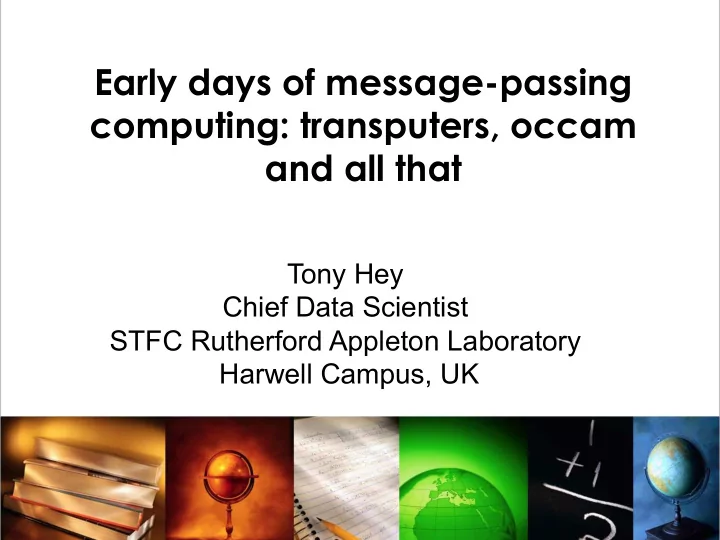

Early days of message-passing computing: transputers, occam and all that Tony Hey Chief Data Scientist STFC Rutherford Appleton Laboratory Harwell Campus, UK
The Beginnings • In 1981 I was on sabba,cal at Caltech – as a theore,cal par,cle physicist – and Geoffrey Fox and I went to a colloquium by Carver Mead … • Carver demonstrated that there were no engineering obstacles to chips geDng smaller and faster for the next 20 years • I went back to the UK and built message-passing machines using the Inmos Transputer • Geoffrey Fox collaborated with Chuck Seitz in building a hypercube message-passing machine that was usable for scien,fic applica,ons
The Caltech Cosmic Cube • Designed and built in the early 1980’s by Geoffrey Fox and Chuck Seitz and their teams in Physics and CS • Processors at nodes of hypercube; message passing between nodes • Experimented with parallelizing a whole set of scien,fic applica,ons • Developed ‘Crystalline OS’ – CrOS – which was really a library of communica,on rou,nes • Demonstrated advantages of virtual addresses, virtual communica,on channels and kernel-like support at each node
Lessons learnt • Exploited data parallelism of regular problems by ‘domain decomposi,on’ • For high efficiency, need for lightweight kernels on nodes that allowed for low latency message start up ,mes • Laid the founda,ons for parallel programming methodology and parallel performance analysis that are s,ll relevant today • Irregular problems were more difficult …
The Parallel Compu7ng Landscape (1) • The Intel Personal Supercomputer – iPSC1 had OSF Mach OS on each node which had very high latency for ini,a,ng communica,ons – iPSC2 released soon aZerwards with NX ‘Distributed Process’ environment based on Caltech’s ‘Reac,ve Kernel’ OS • The Transputer Supernode machine – Based on the Inmos T800 transputer that combined CPU, FPU, memory and communica,on channels on chip – Na,ve programming language was ‘occam’, a realiza,on of a simplified version of Hoare’s CSP – EU ‘Supernode’ project: Machines manufactured by TelMat and Parsys
The Parallel Compu7ng Landscape (2) • Many other vendors of parallel message-passing machines: – nCUBE – Meiko CS-1 and CS-2 – Suprenum – Parsytec – IBM SP series – … Ø Each vendor had proprietary message passing system
Portable Message Passing Interfaces? • The PARMACS macros from the Argonne team – Rusty Lusk et al. ‘Mark 1’ • The p4 parallel programming system – Rusty Lusk et al. ‘Mark 2’ • The Parallel Virtual Machine PVM – Vaidy Sunderam, Al Geist and others – Supported message passing across heterogeneous distributed systems • The PARMACS message passing libraries – Developed by Rolf Hempel and others in the EU ‘PPPE’ project
The Origins of MPI (1) • In 1991 Geoffrey Fox and Ken Kennedy started a community process towards a data parallel Fortran standard – This became the High Performance Fortran effort and typified the ‘heroic’ compiler school of parallel programming • However, what was clearly needed was a lower level standard for portability of message passing programs across different parallel computers – The US were using p4 and Express – The EU were using PARMACS in the PPPE and RAPS projects – PVM was widely used for programming networks of worksta,ons but not op,mized for more closely coupled parallel machines
The Origins of MPI (2) • Workshop on Standards for Message Passing in a Distributed Memory Environment – Williamsburg, Virginia, April 1992 – Organized by Jack Dongarra and David Walker – Sponsored by CRPC and Ken Kennedy urged ac,on • In summer of 1992, I contacted Jack Dongarra about star,ng such a standardiza,on ac,vity – Did not want US and Europe to diverge – Co-wrote a first draZ of an MPI standard with Jack Dongarra, Rolf Hempel and David Walker in October 1992, now known as MPI-0
The Origins of MPI (3) Organized BOF session at SuperCompu,ng 92 in Minneapolis • MPI-0 document served as a catalyst • Marc Snir of IBM emailed me to say ‘he was happy to have been plagiarized’ • I have no idea why we leZ the obvious collec,ve communica,ons rou,nes out of MPI-0 • Rusty Lusk and Bill Gropp from Argonne volunteered to produce an open source implementa,on of the evolving MPI standard • And the EU PPPE project paid for the beer …
The MPI Process • Followed procedures of HPF Forum – Set ambi,ous goal of agreeing a standard within one year • Met every 6 weeks in Dallas airport hotel – I sent Ian Glendinning from my group in Southampton funded by EU PPPE project • In my opinion MPI-1 succeeded because: – Argonne produced an open source implementa,on – Excep,onal technical leadership from people like Marc Snir from IBM and Jim Cownie from Meiko – It was needed and had the support of the community
Parkbench: Portable DM Message- Passing Kernels and Benchmarks • Advent of MPI meant that it was possible to assemble suite of Message-Passing benchmarks for performance analysis of machines and applica,ons • EU Genesis project defined 3 levels of benchmarks – Low-level, Kernels and a set of Compact Applica,ons implemented with PARMACS libraries • Interna,onal Parkbench Group – Combined Genesis methodology with Linear Algebra and NAS Parallel Benchmarks implemented with MPI-1 Ø But the marke,ng community preferred Jack’s Top500 Benchmark …
Acknowledgements • Many thanks to Jack Dongarra, Rolf Hempel and David Walker • A useful ‘aide memoire’ was the ar,cle by Dongarra, Fagg, Hempel and Walker in the Encyclopedia of Electronics and Electrical Engineering (Wiley)
MPI-0 Reference Jack Dongarra, Rolf Hempel, Tony Hey, David Walker ‘A DraZ Standard for Message Passing on Distributed Memory Computers’ Proceedings of the FiZh ECMWF Workshop on the Use of Parallel Processors in Meteorology: “Parallel Supercompu,ng in Atmospheric Science” Editors: Geerd-R Hoffmann and Tuomo Kauranne Published by World Scien,fic, 1993
Recommend
More recommend